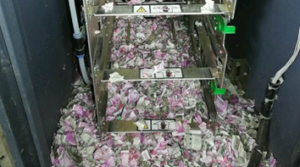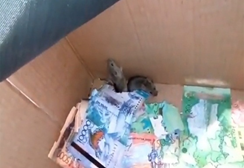 It can be frightening and uncomfortable knowing that you are sharing your living space with creepy and unusual insects. One common insect that many people find frightening and alarming when they are found in their home, is the earwig.
It can be frightening and uncomfortable knowing that you are sharing your living space with creepy and unusual insects. One common insect that many people find frightening and alarming when they are found in their home, is the earwig.
Earwigs get their name from an old superstition that they crawl into the ears of a sleeping person and bore into the brain.
Primarily night feeders, the common earwig is considered to be an insect pest when it feeds on soft plant shoots, such as corn silks, and eats small holes in foliage and flowers. Sometimes ripened fruits are infested, but the damage is usually tolerable. It can be particularly damaging to seedlings.
These slender red-brown insects (3/4 inch long) with elongated, flattened bodies are distinguished by a pair of sharp pincers at the tail end, which they use for capturing prey and mating. There approximately 1,800 species of earwig in the world. Twenty-two species are found in the United States, 12 of which are introduced from other countries. Five species represent pests in homes. A few species have wings, although it is not a strong flier, and usually crawls in search of food.
Earwigs will feed on a variety of vegetation, such as clover, dahlias, zinnias, butterfly bush, hollyhock, lettuce, cauliflower, strawberry, sunflowers, celery, peaches, plums, grapes, potatoes, roses, seedling beans and beets, and tender grass shoots and roots.
Adults overwinter in the soil. Females lay 20-50 cream-colored eggs in underground nests during January and February, and the newly hatched nymphs first appear in April. Nymphs are protected in the nest and do not leave until after the first molt when they must fend for themselves. Young earwigs develop gradually, passing through 4-5 nymphal instars before becoming adults. They are similar in appearance to adults, but lack wings and the large-sized pincers. Most species in this country have one generation per year.
These insects tend to congregate in great numbers there and if you happen to pick up that particular plant, they will get inside your home causing destruction.
Earwigs have been a nuisance this summer both inside the home and out. They are found in bathrooms, kitchens, and basements in addition to outside in the mulch or the birdfeeder.
These insects live together outdoors in large numbers.
Most domestic earwigs prefer moist soil areas with adequate cover and food source. Domestic earwigs and young especially cannot tolerate dry and sunny areas for long. Earwigs can be found under piles of lawn debris, mulch or in tree holes. Even container plants and hanging baskets are a target for earwigs since they are excellent climbers. They gain entry into a structure through exterior cracks. Apartments and homes become an unintentional host to earwigs for two reasons. These insects can invade by accident though human activities or they can actively seek to escape inclement outdoor conditions in our space. If earwigs are snacking on the leaf margins of your seedlings. Occasionally earwigs are carried directly into a facility with the delivery of potted plants, firewood, or other materials. When the substrate dries out, earwigs leave in search of a more humid environment and food.
It is very common to remove the vegetation cover and see dozens of earwigs scurrying about to find hiding places. These common entry points include gaps around poorly sealed doors and windows; through crevices and gaps in the areas where foundations meet siding; through the unscreened attic and foundation vents; and through access doors leading into crawl spaces. In addition, earwigs readily enter structures through homeowner activities.
Earwig invasion: Pincer bugs wriggle into S.F. homes
Ryan T Heuer, Argus LeaderPublished 9:01 a.m. CT July 1, 2016
Earwigs surprisingly want nothing to do with your ears but would like to settle in your home. Here’s what you need to know about these insects.
Kristy Seiler returned from a peaceful vacation to find her home overrun by six-legged intruders.
“They were everywhere,” said Seiler. “In the sinks, in the drain, in the gas burner, in my son’s keyboard, on the walls. … We didn’t know what they were.”
A Google search revealed the answer: earwigs.
The sight of the tiny, roach-like pincer bugs was enough to make Seiler want to move, she said, but her home isn’t the only one to be invaded this summer.
Weather drawing out earwigs in large numbers on Central Coast
Posted: Oct 22, 2016 10:20 AM ISTUpdated: Oct 22, 2016 12:00 PM IST
By Angel Russell
With the warm weather this week, coastal residents are seeing an increase in certain critters in and around their homes.
They’re called earwigs, also known as pincher bugs or pincer bugs, and this week they’ve been coming out a lot more because of the switch in the weather.
Mary Cottle of Morro Bay was out on her porch this week when she noticed her garden overrun by the intruders.
“They are all over the place. They were crawling on my windows,” said Cottle. She says not only were the earwigs crawling around her, the uninvited guests tried to follow her inside her home. “They were very, very much trying to get into my house. It was like a horror movie.”
But her home isn’t the only one to be invaded this week. Exterminators at Brezden Pest Control have been busy picking up phone calls.
“It’s been pretty non-stop this week,” said Josh Leonard of Brezden Pest Control. “Mostly people calling from Morro Bay, Cambria, and Cayucos.”
C Tech Corporation can offer an eco-friendly solution to problems with earwigs.
Our product Combirepel™ is a low-toxic, non-hazardous and insect aversive.
Our product works on the mechanism of repellency. It temporarily inhibits the mating cycle of the insects. The product impairs the ability of the insects to reproduce, that is the insects will not lay eggs or the laid eggs will be infertile. The product causes feeding disruption in an insect by triggering an unpleasant reaction within the insect which might try to feed on the application. The product temporarily blocks the reproduction system of the insects by hindering the release of the vital hormones for growth.
Combirepel™ is available in liquid concentrate which can be diluted in paints as well as available in lacquer form. These products can be directly sprayed or applied on the application. Our product is compliant with RoHS, RoHS2, ISO, APVMA, NEA, REACH and is FIFRA exempted.
The product available in the form of liquid concentrate can be mixed with paints and can be applied to the interior and exterior of homes, hospitals, schools, offices, industries etc. The product is compatible with all types of paints and does not alter the properties of the paints.
The product available in the form of lacquer is a direct application and is compatible with most of the surfaces like wood, concrete, polymer, metal etc.
Our product available in the form of masterbatch can be incorporated into the polymeric applications while they are manufactured to keep them safe from pest attack.
Contact us at technical.marketing@ctechcorporation.com to keep the pests away.
Also, visit our websites:
http://www.ctechcorporation.com/
http://www.rodrepel.com/
http://www.termirepel.com/
http://www.combirepel.com/
Follow our Facebook pages at:
1] https://www.facebook.com/Combirepel-411710912249274/
2] https://www.facebook.com/Termirepel-104225413091251/
3] https://www.facebook.com/Rodrepel-120734974768048/
Follow us on our Twitter pages at:
1] https://twitter.com/rodrepel
2] https://twitter.com/termirepel
3] https://twitter.com/combirepel

















 A pair of mice snuck into an ATM in the Kazakh capital Astana, hiding from a snow storm. Bank workers were surprised when they discovered the tiny intruders and the ruined notes they had munched on during their stay.
A pair of mice snuck into an ATM in the Kazakh capital Astana, hiding from a snow storm. Bank workers were surprised when they discovered the tiny intruders and the ruined notes they had munched on during their stay.










